Pork Neck Bones Are The Flavorful Cut Of Meat Beloved In Southern Dishes
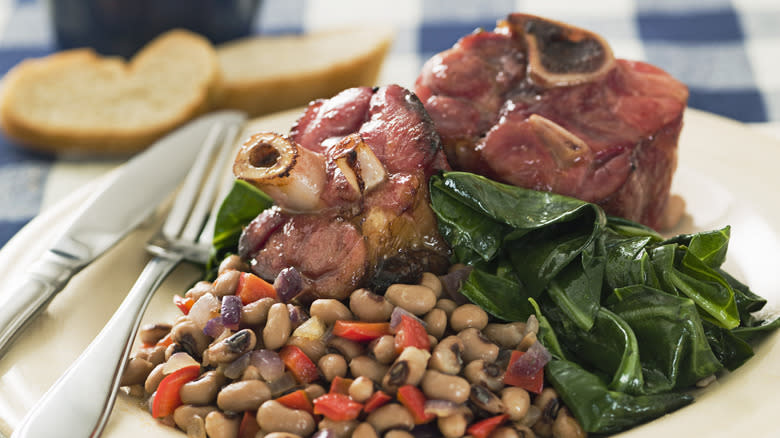
For centuries, the claim to fame for soul food of the American South has relied on less-desirable cuts of meat — organs, offal, bones, and cartilage-heavy stuff. But this was much more of a necessity than a conscious choice. Soul food originated out of necessity across the South; it derives from the cuisine of enslaved and segregated African Americans, most of whom only had access to a limited variety of ingredients. They made the most out of what was available, which was often the less desirable cuts of meat. One of these cuts of meat, pork neck bones, is still prevalent in soul food and other areas of Southern cuisine today.
As a professional cook based in the South, I've worked quite a bit with all parts of the hog, pork neck bones included. These babies are exactly what they sound like: Cuts from the actual neck of the pig. Most often found in center-cut sections, pork necks are mostly bone and connective tissue, with some lean meat and fat. This cut of meat is lauded for its rich flavor and high collagen content.
When slow-cooked, the lean meat and tough connective tissue break down, becoming extremely tender (i.e., "fall off the bone). When exposed to heat over time, collagen in the pork necks — a structural protein stored in bones and connective tissue — begins to unwind and mix with water to form gelatin, which thickens and flavors the water. This makes pork necks ideal for making rich, full-bodied soups and stews.
Read more: Styles Of Regional BBQ In The US
How Are Pork Neck Bones Produced?
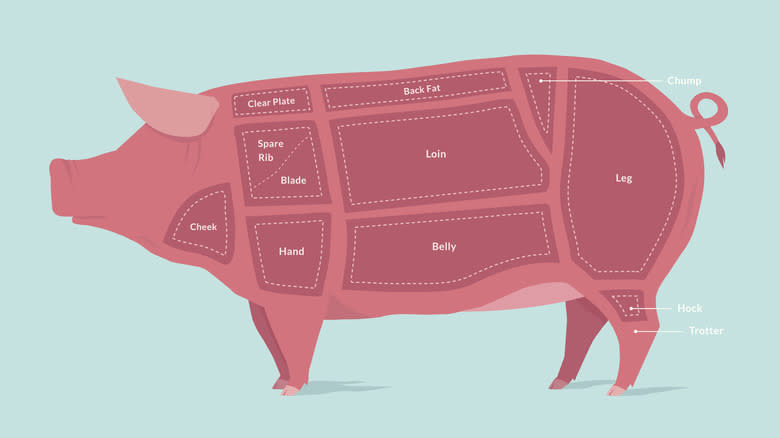
Pork neck bones are mostly a byproduct of the meat industry. When pigs are butchered, their carcasses are divided up into various cuts. Once the neck area is fabricated from the spine and backbone, it undergoes further processing, involving the trimming of excess fat and removing any undesirable bits. While most of the meat is saved for more expensive and tender cuts of pork, the necks are still left with some meat attached to them for substance and flavor.
The necks are then typically cut into sections between spinal vertebrae so that the pieces are small enough to cook manageably with. Because the method of butchery leaves the cut of meat with much less meat than bone and cartilage, pork neck bones are typically sold for much cheaper than other, meatier cuts of pork. This also makes them generally less desirable and less in demand.
Despite being less popular than, say, the widely-adored pork tenderloin, pork neck bones are still a common find in plenty of grocers, butcher shops, farmers' markets, and online purveyors. You might not find pork neck bones readily available in any local grocery store, though they are more common in the Southern United States. If you're having trouble finding pork neck bones for a recipe, you can ask a local butcher who works with whole animals or primal cuts to reserve some for you.
Neck Bones Vs. Ham Hocks

Pork neck bones and ham hocks are both flavorful cuts of the pig often used to enhance the taste of soups, stews, and other slow-cooked dishes. As both bone and cartilage-heavy cuts of pork, it can sometimes be difficult for the inexperienced cook to distinguish how the two cuts differ. Neck bones and ham hocks come from different parts of the pig and are processed differently, bringing different personalities to the recipes.
While neck bones derive from the spine and backbone of the pig, ham hocks come from the part of the pig that attaches its trotter to its leg (the hock joint, the ankle). Because of the proximity to the shoulder, the neck bone of the pork tends to contain more meat than the hock, which contains mostly ligaments and connective tissue (remember, it connects the leg to the foot).
Ham hocks are usually cured in salt and smoked, which imparts a bacon-like flavor to a recipe. Neck bones, on the other hand, are mostly sold raw. Thus, while both cuts of meat will taste different in the end, they both impart a rich body and flavor from their high collagen contents. Thus, you can use both cuts almost interchangeably; throw some neck bones and bacon to substitute a ham hock in collard greens!
What Do Pork Neck Bones Taste Like?
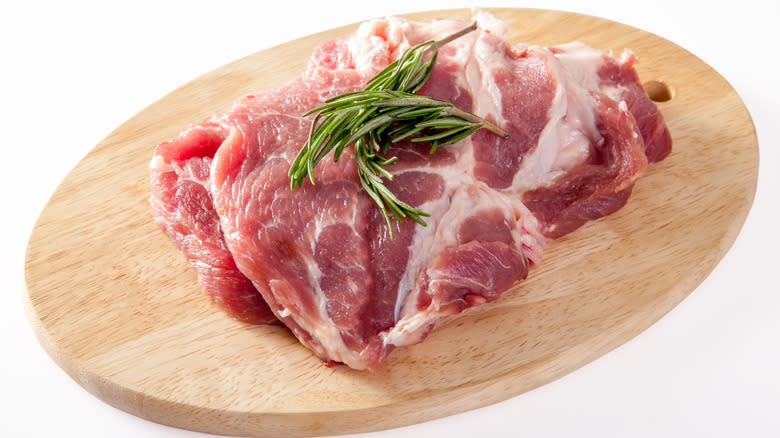
Neck bones are known for being rich and savory — a result of their fat, meat, and connective tissues. Their taste is unique and best broken down by flavor, texture, and smell.
Flavor
Like other forms and cuts of pork, the neck bones are rich in savory flavor, otherwise known as umami. This meaty flavor opens up particularly strongly when salted and cooked for a long time in low, steady heat. The flavor of neck bones, when cooked low and slow as they typically are, can best be described as a complex medium of savory, rich, and slightly sweet. This flavor profile is a result of the leaching of different proteins and sugars from the muscle, connective tissue, and bone marrow of the neck bones when slow-cooked.
Texture
Slow-cooking pork neck bones, when done properly, turns them from tough and rigid to soft and incredibly tender. When cooked this way in liquid, the fat and collagen from the neck bones will render and emulsify with the water to create a rich, thick, and cloudy broth. The connective tissue and flesh of the pork will break down over time, becoming very soft to the touch — a tenderness that some describe as "melt in the mouth" or "fall off the bone."
Smell
The smell of cooked neck bones will depend on other ingredients used, but the pork itself will impart a rich, savory smell to them. They'll simply smell like pork!
How To Cook With Pork Neck Bones
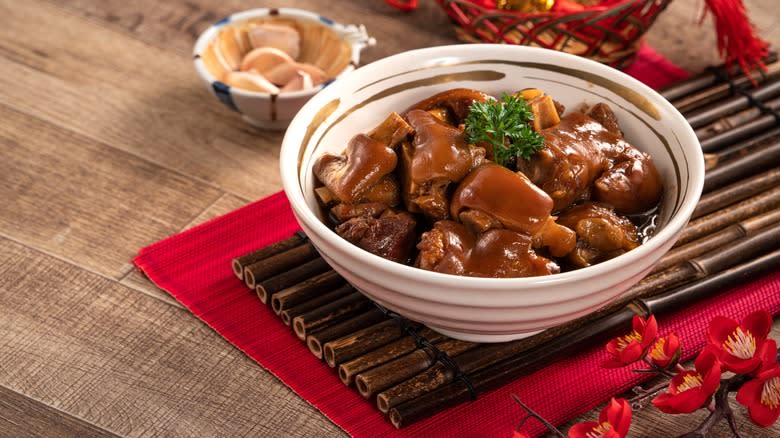
Pork necks, though delicious as an end product, take quite a bit of love and attention before they can be truly appreciated, so don't expect to sear off a couple for a quick weeknight dinner. Because neck bones are a tough and not-so-meaty cut of pork, they should almost always be cooked in a simmering, wet-heat method, such as braising. But there's some prep first.
If you're buying from a butcher, asking if they can clean your pork neck bones can save you time and money on meat. Neck bones often have excess membranes, cartilage, and large veins that need to be removed. If you need to do it yourself, you can start by rubbing the outsides of the sections with an acid like vinegar or citrus before peeling off the nasty bits. You can go even further by blanching your neck bones in boiling water for a few minutes until the grit and grime release and rise to the surface of the pot. Drain and pat dry.
Once your neck bones are clean, season them generously with salt, then heat a large, heavy-bottomed pot over medium-high heat with a coating of oil. Once the oil is hot and streaky, sear the neck bones until they are golden brown on all sides and set them aside to rest. Sauté all other ingredients in the oil before adding your braising liquid and necks back to the pot. Braise the neck bones until tender.
Where To Buy Pork Neck Bones
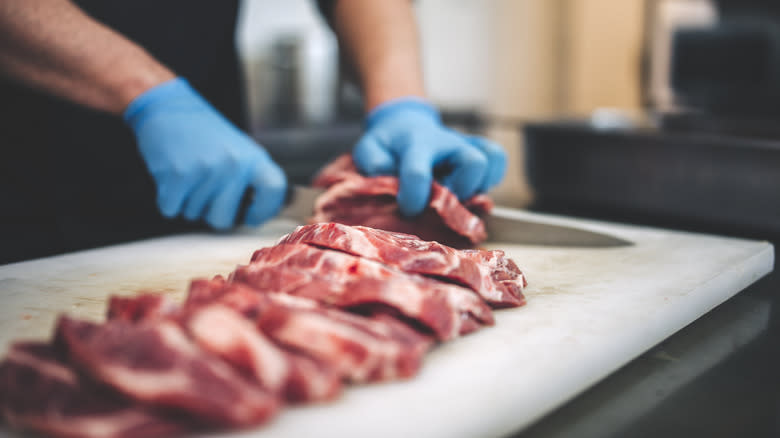
Pork neck bones may not be the most popular cut of the animal, but they aren't terribly hard to find. You won't find this cut too far outside the realm of Southern cooking in American cuisine; therefore, you probably won't find neck bones in every grocery store. But they are much easier to find in the common grocery stores in the Southern states.
If you're not located in the South, you might have better luck looking in specialty butcher shops or ethnic markets — specifically those that cater to African, Asian, and Latin American customers. These cuisines use pork bones in many more recipes than those in America. Butchers who handle whole animals or primal cuts will likely have pork neck bones — if not as a common cut, then likely as a byproduct of fabrication.
Moreover, farmers' markets are another good option to find neck bones. If they're not being sold by the meat farms right then and there, you might be able to talk to the right person to put in a specialty order or at least point you in the right direction of someone who might know more. If you're totally out of luck IRL, there's always the internet. Plenty of online meat purveyors sell and ship bulk pork neck bones — plenty of which are harvested from humanely and sustainably raised pigs.
How To Shop For Pork Neck Bones

As with any fresh cut of meat, when shopping for pork neck bones, you want to guarantee you are buying the freshest, highest-quality product you can find. The best way to shop for meat is to use almost all your senses.
When shopping for pork, your meat should have a vibrant hue with pinkish-colored flesh and moist bones. If you can, look for cuts with the best marbling — that is, consistent layers or streaks of white fat interspersed in the pink flesh. Good marbling means better flavor and texture in your final product. The neck bones should be firm to the touch and should smell clean and mild. All meat you buy should be completely devoid of any unpleasant odor. Bad smells indicate spoilage.
If you're buying pre-packaged meat, check the label for the packing and sell-by dates. Try to opt for the most recent packing date and the sell-by date that is furthest away. Look for signs of damage, leaks, or excessive air, as intact and properly sealed packaging preserves the freshness of the meat.
Finally, if you have the budget for it, it is often worth spending a bit more money on meat that is raised humanely and sustainably. Many online purveyors, specialty butcher shops, and local farms sell regeneratively-raised pork. It's not only better for the planet but also for your body and will likely taste much better.
Varieties Of Pork Neck Bones

While pork neck bones are most often sold raw and in center-cut sections, they can sometimes be purchased in various cuts and preparations depending on what it is you're looking to cook. You may find them cross-cut, whole, or center-cut. They may even be smoked or marinated for you and ready to cook.
Whole pork neck bones, found most often in butcher shops that process whole hogs, consist of the complete neck section featuring bones, meat, and connective tissues. Whole pork necks are quite large, and you'd really only want to use them this way when flavoring a huge pot of stewed food.
Cross-cut pork neck bones present smaller, cross-sectional pieces, exposing marrow and bone structure. Cross-cut bones allow for faster extraction of marrow and collagen when cooking. Center-cut pork neck bones strike a balance between meat and bone, providing versatility for use in various slow-cooked dishes. This cut resembles oxtail and is your most common cut. They're good for searing, as even meat coverage means more even browning around the bone.
Sometimes, you may find pre-smoked, seasoned, or marinated pork neck bones available for convenience. These already-prepared neck bones can save you plenty of prep time if you're in a pinch to get dinner on the stove. Oftentimes, because the smoke, salt, or acid content in the meat acts as a preservative, the pork will have a longer shelf life in the fridge.
How To Store Pork Neck Bones

Remember that quality and freshness are of the utmost importance with any meat product. Therefore, you want to ensure you store your neck bones properly and preserve their fungible integrity so they'll taste great when you finally cook them.
Think about how you bought your neck bones — were they fresh or frozen? Completely raw or prepared? If you buy fresh, raw pork neck bones, you'll want to make sure you use it or freeze it as soon as possible. The USDA recommends refrigerating fresh pork immediately after purchase and using or freezing it for three to five days. If you bought it frozen, keep it frozen until you're ready to use it within the next couple of days.
If you bought your meat marinated, cured, or smoked, you've got a little more time to use it than completely raw, but it depends on how your meat was prepared. Curing and smoking can add weeks, if not months, to the shelf life of pork, while marinating might just give you a few extra days. Make sure you check with the seller to ensure best practice.
Whether refrigerating or freezing meat, though, the less exposure to air, the better. The longer meat is exposed to open air, the quicker it oxidizes and deteriorates. Store your neck bones in air-tight containers, and even vacuum seal them if you can. Store them dry unless they're being actively marinated.
Dishes To Cook Using Pork Neck Bones
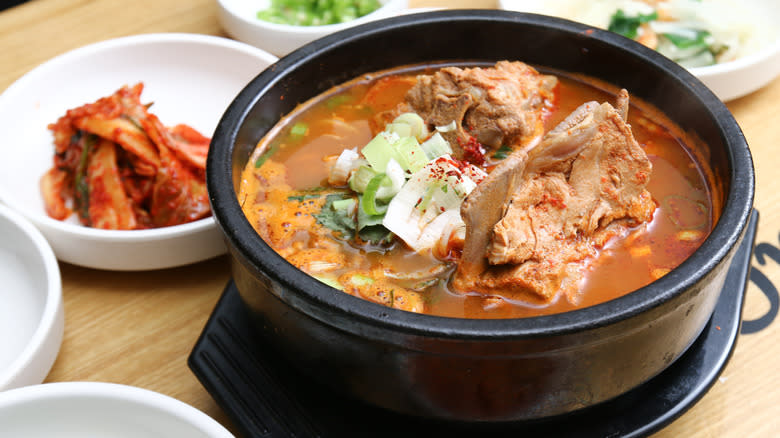
There are a myriad of traditional and non-traditional ways to cook with pork neck bones. In soul food, you use pork necks in Southern braised collard and mustard greens, pasta sauce, and even braised standalone and served with their own gravy. You might consider using pork necks interchangeably for Southern dishes that traditionally call for ham hocks, such as red beans and rice or black-eyed peas.
Pork necks appear frequently in various cuisines around the world. Pork neck does well with the deep flavors of soy and plum sauce and rice wine to create a sticky, char siu-like sauce for Chinese barbecue pork. In the traditional South African Kettle Braai, pork necks are rubbed and marinated in spices and sauces before being cooked over coals and served with stewed peaches.
Generally speaking, all pork bones are great for making rich, milky broths, such as our tonkotsu ramen recipe. Another example is Korean Gamjatang, a pork bone soup made by simmering pork bones, such as necks, with gochujang hot pepper paste to create a hearty, spicy broth.
We hope you give it a shot if you've never cooked with pork necks! Sometimes, the most overlooked cuts of meat are the most versatile and even the most delicious. You might just be surprised by what you cook up.
Read the original article on Tasting Table.

